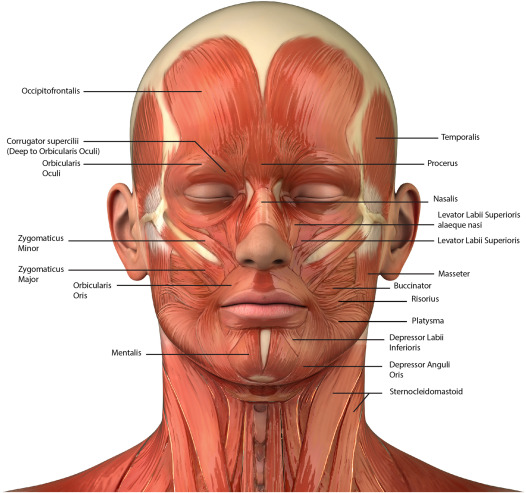muscles of facial expression osmosis video
scalp
made up of 5 layers
skin
connective tissue
aponeurosis
loose connective tissue
pericranium (periosteum)
first 2 layers are connected together tightly called the scalp proper
muscles of facial expression
deep to skin in scalp, face and neck
attached to bones or fascia
muscular sheet forms and spreads across scalp face and neck
carries branches of facial nerve (cranial nerve 7)
occipitofrontalis muscle
2 bellies connected by epicranial aponeurosis
frontal belly
occipital belly
orbicularis oculi
2 parts
palpebral part
orbital part
function
to close the eyelids
palpebral part closes eyelids gently
orbital part closes eyelids tightly
corrugator supercilii (eyebrow muscle)
draws the eyebrows downward and medially when frowning
the nose
3 muscles
procerus
top between eyebrows
depresses medial ends of eyebrows
nasalis
bridge of nose
largest muscle of nose
2 parts
transverse
contracts nostrils
alar
flares nostrils
levator (long name)
comes down on either side of nose
flares nostrils and upper lip
orbicularis oris
encircles the mouth
closes mouth by bringing lips together or protrudes lips
muscles of the upper lip
zygomaticus minor
pull the upper lip upward
zygomaticus major
elevates corner of mouth
levator …. nasi
pull the upper lip upward
levator labii superioris
pull the upper lip upward
levator anguli oris
raises the corner of mouth
risorius
retracts the corner of mouth
muscles of the lower lip
depressor anguli oris
pulls the corner of mouth downwards to express sadness
depressor labii inferioris
pulls the lower lip downward when sad or pouting
both muscles of the lower lip are dilators of the mouth
muscle of the chin
mentalis
elevates and protrudes the lower lip when pouting
muscle of the neck
platysma
broad muscle
depresses mandible, draws corners of mouth downward sand tenses the skin and neck
extends towards the mandible and blends with facial muscles
tenses skin of neck to express stress
buccinator
main function is to press against the cheek when drinking out of a straw

 Knowt
Knowt